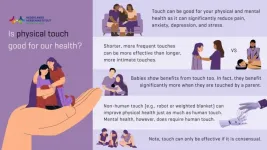(Press-News.org) NEW YORK, NY (April 8, 2024)--A new type of investigational therapeutic in development for pancreatic cancer has shown unprecedented tumor-fighting abilities in preclinical models of the disease, suggesting it has the potential to offer novel treatment options for nearly all pancreatic tumors, a comprehensive study has found.
The inhibitors in this new class of oral medications, being developed by Revolution Medicines Inc., target the oncogenic or active cancer-causing form of RAS proteins (such as KRAS, NRAS, and HRAS). These RAS “oncoproteins” drive up to a third of all human cancers. The research findings—conducted by a consortium of academic researchers led by Columbia scientists and the scientific team at Revolution Medicines—were published in a paper appearing today in Nature.
Currently the third leading cause of death from cancer, pancreatic cancer kills about 50,000 people annually in the United States alone. Despite decades of research, the disease continues to stymie drug developers and oncologists. What’s especially frustrating is that scientists know exactly what causes most cases at the cellular level. “For over four decades, we have known that there’s one particular RAS protein, called KRAS, that’s mutated and drives about 95% of all pancreatic ductal adenocarcinoma cases, and we’ve had no direct tools to attack it for most of that time,” says Kenneth Olive, PhD, associate professor of medicine at Columbia University’s Vagelos College of Physicians and Surgeons and Herbert Irving Comprehensive Cancer Center, one of the study’s senior authors.
When the study’s co-senior author, Mallika Singh, PhD, vice president for translational research at Revolution Medicines, told Olive the company had invented a class of inhibitors that had the potential to target all RAS mutations (link to RVMD Nature pub, Holderfield et al., here), he was incredulous. “My immediate reaction was skepticism,” says Olive. “But I was curious, and we quickly established a collaboration.”
Study results
Preclinical studies soon launched in the Olive lab at Columbia, led by Urszula Wasko, a PhD student in the molecular pharmacology graduate program. Early pilot experiments with RMC-7977 were remarkably effective. “We immediately knew we were working with something entirely different,” says Olive. At the same time, Olive and Revolution Medicines worked to bring together pancreatic cancer experts from other academic institutions, including the University of Pennsylvania, Dana-Farber Cancer Institute, University of North Carolina at Chapel Hill, and Memorial Sloan Kettering. “Rather than compete against one another, we established a consortium and agreed to share data in real time. That was transformative,” says Olive.
Pancreatic cancer researchers have developed many different preclinical models of the disease over the years, each with its own strengths and weaknesses. Rather than pick one, the expanded team tested RMC-7977 in all of them. “By unleashing a consortium of scientists on this problem, we were able to examine active RAS inhibition in every major class of model for pancreatic cancer, and this inhibitor performed really well in all,” says Olive.
The preclinical tumor model Olive’s lab has long favored is widely recognized for its broad resistance to treatment. “RMC-7977 as a single agent outperformed the best combination regimen that has ever been reported in the literature in that model system,” he says, adding that it’s the first time he’s ever seen tumors routinely get smaller in those systems. Other models the consortium tested yielded similar results.
Because RMC-7977 also inhibits wild-type RAS proteins essential to the health of many normal cells, the scientists also carefully examined normal tissues in the treated animals. This work showed that tumor cells are uniquely sensitive to the inhibitor, while the impact in normal cells was minimal.
Though the initial responses in preclinical tumor models to the inhibitor were impressive, Olive hastens to point out that the tumors were not eliminated.
“In almost every case, the tumor came back,” he says. In tissue culture, the investigators identified another oncogene, called MYC, that was altered in most of the resistant tumors, then developed a combination treatment that was effective against tumor cells that had developed resistance to the active RAS inhibitor. Those results suggest a combinatorial approach that is worth exploring in patients in the future.
In a field with a long history of failed drug development efforts, the new results are cause for optimism, Olive says. “I’ve been working on pancreatic cancer for almost 20 years, and I’ve never seen preclinical results like these. I think there is a real chance this approach will help change the standard of care for pancreatic cancer patients, but only clinical trials can determine that. I’m excited that Columbia is one of many institutions participating in the clinical development of these new agents."
More information
The study, titled "Tumor-selective effects of active RAS inhibition in pancreatic ductal adenocarcinoma," was published on April 8, 2024, in Nature.
The full list of authors is included in the article.
###
Columbia University Irving Medical Center (CUIMC) is a clinical, research, and educational campus located in New York City. Founded in 1928, CUIMC was one of the first academic medical centers established in the United States of America. CUIMC is home to four professional colleges and schools that provide global leadership in scientific research, health and medical education, and patient care including the Vagelos College of Physicians and Surgeons, the Mailman School of Public Health, the College of Dental Medicine, the School of Nursing. For more information, please visit cuimc.columbia.edu.
END
Opening a new front against pancreatic cancer
2024-04-08
ELSE PRESS RELEASES FROM THIS DATE:
More premature babies born following Swedish parental leave policy
2024-04-08
The introduction of a policy protecting parental leave benefits in Sweden in 1980 had unintended consequences on child health. The policy led to an increase in premature birth rates. This is shown by a study from researchers at Stockholm University, published in JAMA Pediatrics.
The Swedish so-called speed premium policy was introduced in 1980 in order to protect couples’ level of income-based parental leave benefits when they had children in quick succession. The new study from Stockholm University evaluates the health consequences of the policy. The researchers conclude that by ...
Immune key to chronic viral infections discovered
2024-04-08
IMMUNE KEY TO CHRONIC VIRAL INFECTIONS DISCOVERED
Australian researchers have discovered a previously unknown rogue immune cell that can cause poor antibody responses in chronic viral infections. The finding, published today (9 April) in the journal, Immunity, may lead to earlier intervention and possibly prevention of some types of viral infections such as HIV or hepatitis.
One of the remaining mysteries of the human immune system is why a certain cell, called a B cell, which retains a memory for past infections – ensuring we fight off diseases we have experienced before – often only has a weak capacity to protect us from persistent infections.
Researchers ...
PFAS ‘forever chemicals’ above drinking water guidelines in global source water
2024-04-08
Per-and poly-fluoroalkyl substances – commonly known as PFAS – are a group of over 14,000 human-made chemicals that have been popular since the 1950s for their diverse skills in resisting heat, water, grease and stains.
They’ve been commonly found in household products like non-stick frypans, clothing, cosmetics, insecticides, and food packaging, as well as specialty industry products, like firefighting foam.
But despite their broad skillset, the chemicals have a dark side: they’re known as ‘forever chemicals’ as once they’re in the environment – ...
How the moon turned itself inside out
2024-04-08
About 4.5 billion years ago, a small planet smashed into the young Earth, flinging molten rock into space. Slowly, the debris coalesced, cooled and solidified, forming our moon. This scenario of how the Earth's moon came to be is the one largely agreed upon by most scientists. But the details of how exactly that happened are "more of a choose-your-own adventure novel," according to researchers in the University of Arizona Lunar and Planetary Laboratory who published a paper in Nature Geoscience. The findings offer important insights into the evolution ...
Climate change threatens Antarctic meteorites
2024-04-08
Using artificial intelligence, satellite observations, and climate model projections, a team of researchers from Switzerland and Belgium calculate that for every tenth of a degree of increase in global air temperature, an average of nearly 9,000 meteorites disappear from the surface of the ice sheet. This loss has major implications, as meteorites are unique samples of extraterrestrial bodies that provide insights into the origin of life on Earth and the formation of the Moon.
Disappearing at an alarming rate
By 2050, about a quarter of the estimated of 300,000 - 800,000 meteorites in Antarctica will be lost ...
New study highlights the benefit of touch on mental and physical health
2024-04-08
Through a large-scale analysis, researchers at the Netherlands Institute for Neuroscience have uncovered the ways in which consensual touch can benefit a person’s physical and mental wellbeing.
You might recognize the comforting feeling when someone offers you a hug at the end of a stressful day or strokes your shoulder when you’re feeling down. But the question remains: can touch really help you feel better, and does it matter who it’s from or how they touch you? To explore these questions, researchers from the Social Brain Lab at the Netherlands Institute for Neuroscience and the University Hospital ...
Wyss Institute’s AminoX project receives funding from Northpond Labs to accelerate innovation in protein-based therapeutics
2024-04-08
(BOSTON) — The Wyss Institute for Biologically Inspired Engineering at Harvard University and Northpond Ventures announced today that the VC firm’s affiliate Northpond Labs has signed an agreement to support the development of the AminoX project toward commercialization. This is the fourth Wyss project selected by Northpond Labs for additional funding.
Established in 2020 with the involvement of Harvard’s Office of Technology Development, the five-year strategic research alliance created The Laboratory for Bioengineering Research and Innovation at the Wyss Institute through a $12 million commitment from Northpond Labs to support impactful research ...
How scientists are accelerating chemistry discoveries with automation
2024-04-08
A new automated workflow developed by scientists at Lawrence Berkeley National Laboratory (Berkeley Lab) has the potential to allow researchers to analyze the products of their reaction experiments in real time, a key capability needed for future automated chemical processes.
The developed workflow – which applies statistical analysis to process data from nuclear magnetic resonance (NMR) spectroscopy – could help speed the discovery of new pharmaceutical drugs, and accelerate the development of new chemical reactions.
The Berkeley Lab scientists who developed the groundbreaking technique ...
An inside look at how plants and mycorrhizal fungi cooperate
2024-04-08
For millions of years, underground fungi have lived in symbiosis with plant roots. Plants provide photosynthesized carbon, while fungi deliver water and nutrients. In order to do so, these organisms share space at cellular scale: fungi stretch a network of tendrils called arbuscules into a plant’s root cells, and both organisms rearrange their cells around this structure to facilitate sharing.
Recently, researchers have been able to study both sides of this interaction up close, using RNA sequencing to understand gene expression: one of the first cross-kingdom spatially-resolved transcriptomics studies to date. This paper ...
Do opponents’ race, gender, and party impact US congressional fundraising?
2024-04-08
Donations for a political candidate can be motivated by support for that candidate or by opposition to the candidate’s opponent. New research published in Social Science Quarterly found that female Democrats and non-white male Democrats in the United States have a fundraising advantage when running against a white male Republican. Female Republicans or non-white male Republicans do not have this advantage when running against white male Democrats.
To assess the impact that race, gender, and party ...




